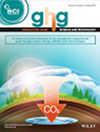求助PDF
{"title":"CO₂ sequestration and soil improvement in enhanced rock weathering: A review from an experimental perspective","authors":"Lianghan Cong, Shuaiyi Lu, Pan Jiang, Tianqi Zheng, Ziwang Yu, Xiaoshu Lü","doi":"10.1002/ghg.2313","DOIUrl":null,"url":null,"abstract":"<p>Enhanced rock weathering (ERW) is an emerging negative emission technology (NET) with significant potential for mitigating climate change and improving soil health through the accelerated chemical weathering of silicate minerals. This study adopts a critical research approach to review existing ERW experiments, focusing on the mechanisms of soil improvement and CO₂ sequestration, as well as the economic costs and environmental risks associated with its large-scale implementation. The results demonstrate that while ERW effectively enhances soil pH and provides essential nutrients for crops, its CO₂ sequestration capacity is highly dependent on variables such as soil type, rock type, application rate, and particle size. Furthermore, the economic feasibility of ERW is challenged by high costs related to mining, grinding, and transportation, and environmental risks posed by the release of heavy metals like Ni and Cr during the weathering process. Notably, significant discrepancies exist between laboratory experiments and field applications, highlighting the need for extensive in-situ monitoring and adjustment of ERW practices. This study underscores the importance of optimizing ERW strategies to maximize CO₂ sequestration while minimizing environmental impacts. Future research should focus on long-term field experiments, understanding secondary mineral formation, and refining the application techniques to enhance the overall efficiency and sustainability of ERW. © 2024 Society of Chemical Industry and John Wiley & Sons, Ltd.</p>","PeriodicalId":12796,"journal":{"name":"Greenhouse Gases: Science and Technology","volume":"14 6","pages":"1122-1138"},"PeriodicalIF":2.7000,"publicationDate":"2024-11-12","publicationTypes":"Journal Article","fieldsOfStudy":null,"isOpenAccess":false,"openAccessPdf":"","citationCount":"0","resultStr":null,"platform":"Semanticscholar","paperid":null,"PeriodicalName":"Greenhouse Gases: Science and Technology","FirstCategoryId":"93","ListUrlMain":"https://onlinelibrary.wiley.com/doi/10.1002/ghg.2313","RegionNum":4,"RegionCategory":"环境科学与生态学","ArticlePicture":[],"TitleCN":null,"AbstractTextCN":null,"PMCID":null,"EPubDate":"","PubModel":"","JCR":"Q3","JCRName":"ENERGY & FUELS","Score":null,"Total":0}
引用次数: 0
引用
批量引用
Abstract
Enhanced rock weathering (ERW) is an emerging negative emission technology (NET) with significant potential for mitigating climate change and improving soil health through the accelerated chemical weathering of silicate minerals. This study adopts a critical research approach to review existing ERW experiments, focusing on the mechanisms of soil improvement and CO₂ sequestration, as well as the economic costs and environmental risks associated with its large-scale implementation. The results demonstrate that while ERW effectively enhances soil pH and provides essential nutrients for crops, its CO₂ sequestration capacity is highly dependent on variables such as soil type, rock type, application rate, and particle size. Furthermore, the economic feasibility of ERW is challenged by high costs related to mining, grinding, and transportation, and environmental risks posed by the release of heavy metals like Ni and Cr during the weathering process. Notably, significant discrepancies exist between laboratory experiments and field applications, highlighting the need for extensive in-situ monitoring and adjustment of ERW practices. This study underscores the importance of optimizing ERW strategies to maximize CO₂ sequestration while minimizing environmental impacts. Future research should focus on long-term field experiments, understanding secondary mineral formation, and refining the application techniques to enhance the overall efficiency and sustainability of ERW. © 2024 Society of Chemical Industry and John Wiley & Sons, Ltd.
增强岩石风化过程中的二氧化碳封存和土壤改良:从实验角度综述
增强岩石风化(ERW)是一种新兴的负排放技术(NET),通过加速硅酸盐矿物的化学风化,具有减缓气候变化和改善土壤健康的巨大潜力。本研究采用批判性的研究方法,回顾了现有的ERW实验,重点研究了土壤改良和CO 2固存的机制,以及大规模实施的经济成本和环境风险。结果表明,虽然ERW有效地提高了土壤pH值,并为作物提供了必需的养分,但其CO 2固存能力与土壤类型、岩石类型、施用量和粒径等变量高度相关。此外,战争遗留爆炸物的经济可行性受到采矿、研磨和运输的高成本以及风化过程中Ni和Cr等重金属释放带来的环境风险的挑战。值得注意的是,实验室实验和实地应用之间存在重大差异,突出表明需要广泛的现场监测和调整战争遗留爆炸物的做法。这项研究强调了优化剩余物处理策略的重要性,以最大限度地减少二氧化碳的吸收,同时最大限度地减少对环境的影响。未来的研究应着眼于长期的野外试验,了解次生矿物的形成,完善应用技术,以提高剩余物的整体效率和可持续性。©2024化学工业协会和John Wiley &;儿子,有限公司
本文章由计算机程序翻译,如有差异,请以英文原文为准。

 求助内容:
求助内容: 应助结果提醒方式:
应助结果提醒方式:


